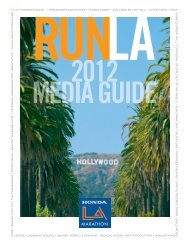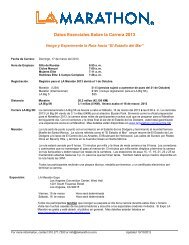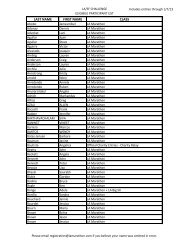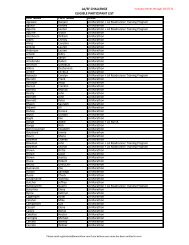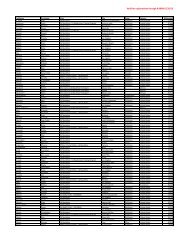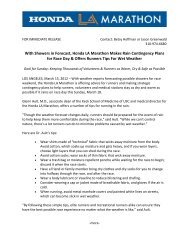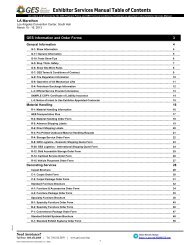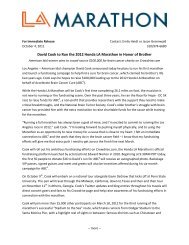2013 media guide - LA Marathon
2013 media guide - LA Marathon
2013 media guide - LA Marathon
You also want an ePaper? Increase the reach of your titles
YUMPU automatically turns print PDFs into web optimized ePapers that Google loves.
ABOUT THE RACE<br />
ABOUT THE RACE<br />
Mile 9: <br />
Ending at Hollywood Boulevard and Edgemont Street <br />
(Elevation change: +48, from 362 to 410 feet) <br />
The route transitions onto Hollywood Boulevard at North Virgil Avenue/North <br />
Hillhurst Avenue, and includes a 3.20-‐mile stretch on Hollywood Boulevard (miles 8-‐<br />
12), moving through the City’s Los Feliz district. <br />
Barnsdall Art Park is located at 4814 Hollywood (at Vermont Avenue) and was <br />
donated in 1927 as an arts center by Aline Barnsdall. It includes Frank Lloyd <br />
Wright’s famed Hollyhock House (1921). <br />
Mile 10: <br />
Ending at Hollywood Boulevard and Wilton Place <br />
(Elevation change: -‐14 feet, from 410 to 396 feet) <br />
Situated along Hollywood between Normandie Avenue and Western Avenue are <br />
both “Thai Town” and “Little Armenia.” Los Angeles has the largest number of <br />
people of Thai descent of any city in the world outside of Thailand. The area was <br />
designated “Thai Town” by the Los Angeles City Council in 1999; the Council later <br />
recognized the area from Vermont Avenue on the east end to Van Ness Avenue on <br />
the west as “Little Armenia” in 2000. <br />
Mile 11: <br />
Ending at Hollywood Boulevard at Wilcox Avenue <br />
(Elevation change: -‐10 feet, from 396 to 386 feet) <br />
“Hollywood” proper begins at Gower Street, where the Hollywood Walk of Fame <br />
begins; the Walk continues west to La Brea Avenue. There are nearly 2,500 stars <br />
today along the Walk of Fame on Hollywood Boulevard and Vine Street. Most <br />
recently, late actor Richard Burton received the 2,491 st star on March 1 st , <strong>2013</strong>. <br />
Hollywood landmarks are scattered along the route: the Museum of Death (6031 <br />
Hollywood), opened in Los Angeles in 2009 with memorabilia from the Black Dahlia, <br />
Charles Manson and other infamous cases; the Music Box @ Fonda (6126 <br />
Hollywood), which opened in 1926, was known for many years as the Henry Fonda <br />
Theater. <br />
At the center of the Walk of Fame is the intersection of Hollywood & Vine, which <br />
became famous for its concentration of radio and motion picture-‐related <br />
businesses in the 1920s. Just north of the intersection is the Capitol Records Tower <br />
(1750 Vine Street), the world’s first circular office building, which was designed by <br />
Welton Becket and opened in 1956. <br />
Continuing on Hollywood Boulevard is the Pantages Theater (6233 Hollywood, <br />
between Argyle Avenue and Vine), an Art Deco-‐style performing arts venue that <br />
opened in 1930 as a vaudeville and movie house. It was home to the Academy <br />
Awards from 1950 to 1960; it is now a conventional theater and underwent <br />
renovation in 2000. <br />
Mile 12: <br />
Ending at Sunset Boulevard and LaBrea Avenue <br />
(Elevation change: -‐35 feet, from 386 to 351 feet; 2 turns) <br />
The route now moves through the heart of Hollywood, with many historical <br />
locations, including the Musso & Frank Grill (6667 Hollywood, between Cherokee <br />
and Las Palmas Avenues), which opened in 1919 and is still in operation, covered <br />
with photos of diners from the Golden Age of Hollywood like Charlie Chaplin, <br />
Douglas Fairbanks, Orson Welles and many others. <br />
Other landmarks along this mile include the American Cinematheque, including the <br />
Egyptian Theatre (6712 Hollywood), the first Egyptian–style theater in the United <br />
States. It opened in 1922 under Sid Grauman (of Chinese Theatre fame) and was <br />
refurbished in 1998. Next door is the Pig ‘N Whistle restaurant, which opened in <br />
1927 to serve diners who were not allowed to eat in theaters at the time. Finally, <br />
runners will also pass the original Frederick’s of Hollywood (6751 Hollywood), which <br />
opened in 1947. <br />
Near the intersection of Hollywood and Highland Avenue is the Hollywood Wax <br />
Museum (6767 Hollywood, opened in 1965) as well as Ripley’s Believe or Not! <br />
Odditorium (6780 Hollywood). This is also the site of the El Capitan Theatre (6838 <br />
Hollywood), which was opened by Grauman in 1926, and refurbished by the Walt <br />
Disney Company in 1991. <br />
The massive Hollywood & Highland retail and entertainment development, <br />
decorated with movie history themes, in 2001. It includes the Dolby Theatre <br />
(formerly the Kodak Theater), which has been the home of the Academy Awards <br />
since 2002. In 1958, the first eight stars of the Hollywood Walk of Fame were <br />
installed at this intersection. <br />
Grauman’s Chinese Theater (6801 Hollywood) was the third of Grauman’s themed <br />
theaters, and opened in 1927. The theater is well known for the 200+ handprints, <br />
footprints and signatures immortalized in the concrete in front of the building, <br />
beginning with actress Norma Talmadge in 1927. The theater hosted the Academy <br />
Awards from 1944 to 1946, and is still in use today as a movie theater. <br />
Madame Tussauds Hollywood (6933 Hollywood) opened in 2009, and today has a <br />
collection of more than 100 wax figures in its three-‐story building. In June 2012, the <br />
museum unveiled its wax figure of 90-‐year-‐old Betty White, the oldest celebrity <br />
depicted in its collection. <br />
18 ASICS <strong>LA</strong> MARATHON<br />
MEDIA GUIDE<br />
19



